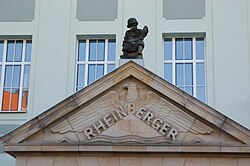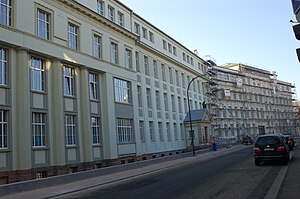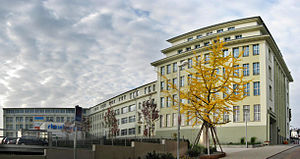Rheinberger (shoe factory)
Eduard Rheinberger AG was the name of a shoe factory in Pirmasens . With over 2500 employees, the company was at times Germany's largest shoe factory.
history

In September 1882 founded Eduard Rheinberger (1856-1918) with 15 employees whose shoe factory in the Hussars stable in Pirmasens . Two years later, the company with 100 workers moved into its own building on Ringstrasse. After expanding production, Rheinberger bought a large site in Schachenstrasse in 1903. A new factory building erected there in 1905 was enlarged until 1911. Soon 1,500 people were working for Rheinberger. In Clausen and Lemberg , sub-companies were founded that manufactured shoe parts. In the meantime, Eduard Rheinberger's sons Gustav joined the company in 1909 and Robert (1894–1937) a year later.
After the First World War and the death of Eduard Rheinberger on March 10, 1918, Gustav and Robert took over management of the factory. In 1920 the building was increased and the company was converted into a stock corporation in 1923 with a share capital of six million Reichsmarks ; Members of the Rheinberger family held all the shares. In 1925, the seven-storey Hans Sachs building was built as the head building of the factory on the corner of Fröhnstrasse and Schäferstrasse. Two years later, 1,800 workers were producing 5,000 pairs of shoes a day. New sales markets in Denmark, England, Austria, Switzerland and the Balkans were opened up. Until 1937, the factory buildings were expanded several times and the number of employees grew to 2,300. Robert Rheinberger passed away that year.
In the interwar period, the company distinguished itself through its social commitment to its employees: a retirement home for former employees was built in 1927-28, and after the construction of the first company apartments in what is now Rheinbergerstrasse in the Winzler district , a whole Rheinberger estate was later built on the Schachen . One of the downsides of the company's history, on the other hand, is that Rheinberger, along with other large German companies such as Salamander and Fagus, took part in material tests on the shoe test track in Sachsenhausen concentration camp during the Second World War , in which numerous prisoners were killed.
When the town of Pirmasens had to be evacuated in September 1939, Gustav Rheinberger acquired a second plant in Offenbach , in which 1,200 employees produced shoes by August 1940. After relocating production back to Pirmasens, mainly shoe parts - such as frames - were produced in Offenbach . Eduard Rheinberger, son of the late Robert, managed the branch on the Main. An air raid on March 19, 1944 led to the destruction of the factory in Offenbach, while more than half of the headquarters burned out in the two nights between March 19 and 21, shortly after the devastating air raid on Pirmasens on March 15, 1945. With just 30 workers, Gustav Rheinberger resumed production in 1945. In 1946 about 200 machines were dismantled and transported away as reparations . In 1950 the currency of the share capital was changed to six million DM. A year later, the workforce grew to over 2,500 employees. The slogan “Rheinberger master shoes” became a quality concept. The younger Eduard Rheinberger died in 1953 and his brother Klaus took over the factory in Offenbach. In 1962 the company produced 1.5 million pairs of shoes.
After the death of the first honorary citizen of the city of Pirmasens - Gustav Rheinberger - on January 23, 1968 and the beginning of the decline of the shoe industry in Pirmasens, the shares of the company, with 700 employees, were sold to two private banks for 12 million DM. From these, the Hauensteiner Josef Seibel Schuhfabrik GmbH acquired the remains of the Rheinberger company in the same year . After the shoe production with the remaining 250 employees had been relocated to Schwanheim , the company was finally closed in the years 1995–1996.
outlook
In 2007, the city of Pirmasens began to convert the former company premises into a business park and dilapidated parts of the building were demolished. With the remaining size of the building complex of around 18,000 m 2 of usable space, an investment of around € 19 million was calculated. The financing was covered by a donation of € 1 million from the Rheinberger descendant Klaus Rheinberger, funds from the federal pilot project Urban Redevelopment West and state funds. At the end of April 2008, the first Science Center in Rhineland-Palatinate , the Dynamikum , was opened in part of the building .
facts and figures
While 14,000 people were employed in 243 Pirmasens shoe factories in 1914, this number rose to 22,000 by 1970. Today only about 1,200 work in shoe production, 500 of them at Peter Kaiser alone . At Rheinberger , the number of workers rose from just under 15 when it was founded in 1882 to over 1,500 (1905) to 2,500 in 1937. After that, the decline began over 700 people in 1973, down to 250 when it was closed.
Web links
Individual evidence
- ↑ ( page no longer available , search in web archives: Dynamikum Zeitung ), special edition of the Pirmasenser Zeitung on April 26, 2008, p. 11.
- ↑ a b c d e f ( page no longer available , search in web archives: Dynamikum Zeitung ), special edition of the Pirmasenser Zeitung on April 26, 2008.
- ^ A b c Albert Gieseler: Eduard Rheinberger GmbH, shoe factory .
- ↑ a b c d e Julius Ganser: 100 years Rheinberger. 1882-1982. Pirmasens, 1982.
- ↑ a b Eduard Rheinberger AG shares in Pirmasens , at HWPH Historisches Wertpapierhaus AG.
- ↑ a b Eduard Rheinberger AG shares, at the Benecke & Rehse share archive.
- ↑ Gerhard and Evelyn Stumpf: Beloved Pirmasens . 1st edition. Vol. 11 (1919-1929). Komet-Verlag, Pirmasens 1992, ISBN 3-920558-15-4 .
- ↑ Anne Sudrow: The Shoe in National Socialism. A product story in a German-British-American comparison . Wallstein, Göttingen 2010, ISBN 978-3-8353-0793-3 , p. 534.
- ↑ http://www.wirtschaftsgeschichte-rlp.de/az/r/rheinberger-ag.html , accessed on July 27, 2017.
- ↑ a b LRP.DE: Catch up with the future on quiet feet , Lebendiges Rheinland-Pfalz , Heft III – IV, 2004, ISSN 0934-9294 .
- ↑ GIU Society for Innovation and Enterprise Development Corporation: Project Development "Rheinberger" Pirmasens, ( Memento of 19 July 2011 at the Internet Archive ) (PDF, 365 kB) 10/2005 (Web Archive).
- ↑ Peter Thiessen: The big names and what remains of them: Rheinberger, Neuffer and Salamander. in Catch up with the future on quiet feet, Lebendiges Rheinland-Pfalz , Heft III – IV, 2004, ISSN 0934-9294 , p. 35.
- ↑ ( page no longer available , search in web archives: Dynamikum Zeitung ), special edition of the Pirmasenser Zeitung on April 26, 2008, p. 16.
- ↑ Federal Ministry of Transport, Building and Urban Development: Stadtumbau West ( Memento from September 28, 2007 in the Internet Archive ) (PDF; 723 kB)
Coordinates: 49 ° 12 '7.17 " N , 7 ° 36' 0.43" E


